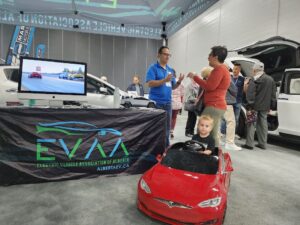
The Electric Vehicle Association of Alberta (EVAA) is in full support of the federal zero-emission vehicle regulations, an important step towards a cleaner, sustainable future. This initiative includes options such as fuel cell vehicles, aligning with Alberta’s industry, and plug-in hybrid electric vehicles (PHEVs) that address particular use cases where battery electric vehicles (BEVs) may not yet be suitable for.
The rate of charging infrastructure growth in Alberta continues to increase. With the added focus of Canada’s mandate (which joins similar mandates from countries around the world), charging stations will continue to proliferate, and is expected to be able to cover the vast majority of the province by 2035. Again, the inclusion of PHEVs is critical, as it ensures no Albertan will be without new vehicle options to meet their business, personal, or recreational transportation needs.
Importantly, Albertans can continue using their existing internal combustion engine vehicles past 2035. This policy is about increasing environmentally responsible options, not removing current vehicles.
We acknowledge concerns about the grid’s capacity. However, the plan to gradually phase out new ICE vehicles by 2035, coupled with the fact that EVs primarily charge overnight during low-demand periods, provides sufficient time for the necessary upgrades and expansion of the grid. Furthermore, the continued use of existing ICE vehicles well beyond 2035, due to natural buying cycles and vehicle lifespans, offers additional time for the grid to evolve to meet far future demands. This ensures a practical and achievable shift towards environmentally friendly transportation.
The transition towards electric and other zero-emission vehicles is a global movement, and Canada’s mandate signals to the automotive industry that we are committed to being part of this change. This policy not only ensures Canada remains on the radar for vehicle distribution but also encourages continued investment in our country. We are excited to see recent investments in battery manufacturing facilities out east, and want Canada to benefit from mining for essential materials, and the expansion of charging networks, all of which are vital for supporting this technological shift and economic growth.
We look forward to a collaborative transition to a greener automotive future.
More info on the EVAA and EVs in Alberta can be found at albertaev.ca, x.com/pluginalberta, Electric Vehicle Assn. of Alberta (EVAA) Group
Hi, I have some questions. What kind of warranty does an electric vehicle have.
? Is there a standard across the board? Are the dealers a full service dealer to repair everything, i.e. body repair? What are electric vehicles crash test rated at? Exactly how does a plug in hybrid vehicle differ from a regular hybrid? How many batteries does a EV have and how much do they weigh? What is the cost to replace air bags once they are deployed. I found out about your organization listening to A.M.As podcast. At the end of the podcast one of said to reach to you guys if I have a question – so here are my questions. Thank you.
While warranties differ between manufacturers, typically the EV specific components are warranties for 8 years/high kilometers.
Dealers (where applicable) typically have to meet manufacturers standards before they can sell EVs, to ensure they are able to properly address and service issues. Body work is usually still performed by 3rd party auto body shops.
Thanks, in part, to the lack of an engine, many EVs are have extremely positive crash test results. https://www.cnet.com/roadshow/news/how-electric-cars-are-crash-tested-for-top-safety-ratings/
Plug in hybrids (PHEV) have somewhat larger battery capacities then non plus in hybrids. When plugged in, this often allows their owners to drive do their typical daily commute to work and neck entirely on electricity, burning no fuel.
The number of batteries will vary with each EV, with common ranges between 3000-5000 cells, but some models have being lower and higher than that range.
A Tesla Model Y weights 2032kg, collared to a similar ICE, Audi Q5 @ 2150kg.
The Ford F150 Lightning is 2900kg compared to an ICE F150 which can weigh up to 2600kg.
While we don’t have air bag costs handy, they won’t be any different than air bags in non EVs.
We are glad to hear you have been listening to the AMA podcast! If you have any other questions, ask away, or check out our active Facebook group https://AlbertaEV.ca/facebook